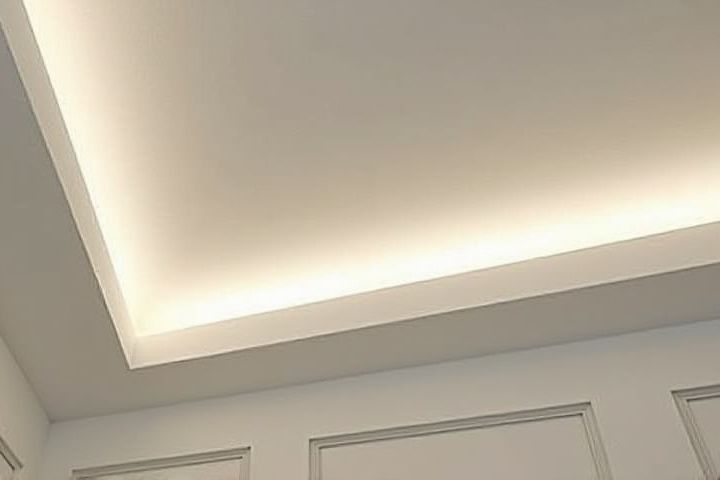
False ceilings, also known as drop ceilings or suspended ceilings, serve multiple purposes in residential design. They enhance aesthetic appeal by providing a smooth and uniform surface for lighting fixtures and HVAC systems, allowing for creative design options. This ceiling type also improves insulation and energy efficiency, helping to regulate temperature by providing an extra layer of protection against heat loss. Additionally, false ceilings can conceal electrical wiring, plumbing, and ductwork, maintaining a clean and organized look in your living spaces. Finally, they contribute to soundproofing by reducing noise levels between floors, promoting a more peaceful environment within your home.
Why Do Houses Have False Ceilings
Improved Insulation
False ceilings significantly enhance insulation in homes, reducing energy costs by up to 30%. By creating an air gap, they prevent heat transfer, keeping spaces warmer in winter and cooler in summer. This insulation effect also minimizes noise pollution, which can lower decibel levels by 20-30%. You can enjoy a quieter, more energy-efficient living environment with effective false ceiling installation.
Enhanced Aesthetic Appeal
False ceilings significantly enhance the aesthetic appeal of your home by creating a polished and modern look. With various design options, such as recessed lighting or unique patterns, they can transform an ordinary room into a visually striking space. Typically installed 8 to 12 inches below the original ceiling, false ceilings can also conceal ductwork, electrical wiring, and plumbing, resulting in a cleaner appearance. Overall, opting for a false ceiling adds depth and character to your interiors while allowing for versatile lighting solutions.
Concealed Wiring and Ducts
False ceilings provide an effective solution for concealing wiring and ducts, enhancing both aesthetics and functionality in your home. This design feature allows you to hide unsightly electrical and HVAC systems, creating a clean and organized appearance. Typically, false ceilings can lower the overall ceiling height by 4 to 12 inches, depending on the type of materials and installation methods used. With proper planning, you can also improve insulation and soundproofing, making your living space quieter and more energy-efficient.
Acoustic Benefits
False ceilings significantly enhance the acoustic properties of a space by reducing sound transmission and minimizing noise pollution. They create an air gap that acts as insulation, absorbing and dampening sound waves, which is particularly beneficial in multi-story buildings or shared living environments. Additionally, the choice of materials such as acoustic tiles can further optimize soundproofing, improving the overall auditory experience in your home. By incorporating false ceilings, you not only achieve aesthetic appeal but also cultivate a more tranquil living atmosphere.
Fire Safety Features
False ceilings, commonly found in residential and commercial buildings, enhance fire safety by acting as an additional barrier against flames and smoke. Typically constructed from fire-resistant materials, these ceilings can slow the spread of fire by containing it temporarily, providing crucial time for evacuation. Many false ceiling systems integrate fire-rated insulation that maintains structural integrity under high temperatures, often rated for specific fire resistance durations, such as 1 to 2 hours. By including smoke detectors and sprinklers within the cavity of a false ceiling, you can significantly improve the overall safety of your space, ensuring a proactive approach to fire hazards.
Energy Efficiency
False ceilings significantly enhance energy efficiency by improving insulation and reducing heat loss or gain. By providing an air barrier, they help maintain a consistent indoor temperature, which can lower heating and cooling costs by up to 20%. Additionally, false ceilings can accommodate energy-efficient LED lighting solutions, further decreasing energy consumption. With the potential for soundproofing, they also create a more comfortable living environment, making your home not only more efficient but also more enjoyable.
Reduced Room Volume for Easier Heating/Cooling
False ceilings create a smaller room volume, allowing for more efficient heating and cooling. By reducing the space that needs climate control, HVAC systems operate more effectively, leading to lower energy costs. This design not only enhances temperature regulation but also improves the overall aesthetic of the room by concealing wiring and ducts. You'll find that false ceilings can enhance sound insulation, providing a quieter and more comfortable living environment.
Moisture Resistance
False ceilings enhance moisture resistance in homes by creating a barrier between the living space and potential sources of humidity, such as kitchens and bathrooms. These ceilings are typically made from materials like gypsum board, which can absorb some moisture, but when installed properly, they effectively prevent water damage and mold growth. In humid climates, the use of ceiling tiles designed specifically for wet environments can further improve this resistance, protecting your interiors. By maintaining controlled humidity levels, false ceilings contribute to the longevity and structural integrity of the home.
Easier Installation of Recessed Lighting
False ceilings facilitate the easier installation of recessed lighting by providing a streamlined structure that conceals wiring and fixtures. This design allows for precise placement of lights without obstructing the overall aesthetics of the room. You benefit from the flexibility of adjusting light intensity and direction while maintaining a clean and modern look. Additionally, false ceilings help improve energy efficiency by reducing heat loss, enhancing both functionality and comfort in your living spaces.
Structural Concealment
False ceilings effectively conceal structural components such as electrical wiring, plumbing, and HVAC ductwork, enhancing the aesthetic appeal of your living space. By creating a seamless look, these ceilings also allow for better lighting options, enabling the installation of recessed lights and ambient lighting systems. In many cases, this design approach can improve insulation, contributing to energy efficiency and potentially lowering utility bills by maintaining a consistent room temperature. With heights of around 8 to 12 inches typically added, false ceilings not only hide unsightly elements but also provide an opportunity for creative interior design.
